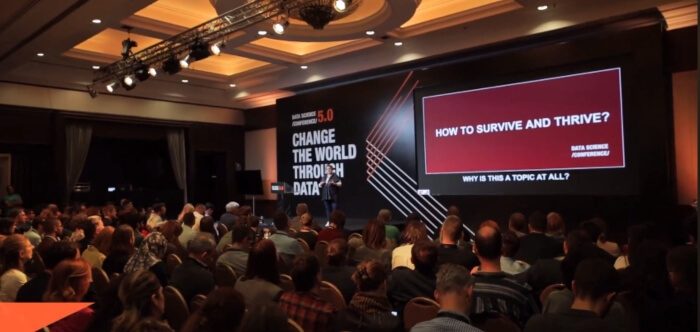Scientific conferences are places where people share knowledge and also leave lasting impressions through their work and presence. While presentations matter the most, attire also plays a quiet role in how one is perceived. It is common for someone to think, Can I wear jeans to a scientific conference?
You can wear jeans to a scientific conference only if the event is casual or does not mention a strict dress code. At formal or international conferences, jeans may look too casual and affect your professional image. In such cases, semi-formal or business casual clothing is the better choice.
Do you want to know when jeans are acceptable, when they are not, and what better options you can pick? If you are curious about these details, keep reading because this article explains every factor you should know before deciding what to wear.
Can I Wear Jeans to a Scientific Conference?
Conferences often raise a simple question: what should you wear? Some people keep it casual, while others prefer a more formal look. Jeans may be fine in daily life, but at a scientific event, the expectations can feel different. To make the right choice, it helps to look at the factors that decide if jeans are suitable.

Conference Type
The type of conference plays a big role in deciding what you should wear. A small local event may allow casual outfits like jeans, while big international conferences usually expect more formal clothing. Some conferences even share scientific conference dress code details in their invitations. Knowing the type of event helps you choose wisely.
Professional Image
Conferences are not only about learning but also about meeting professionals in the field. Wearing jeans can sometimes look too casual, which might affect how others see you. A neat and slightly formal outfit shows that you respect the event. People often remember first impressions, so think carefully before choosing.
Speaker vs. Attendee
If you are a speaker, it is usually better to dress more formally. The audience will look at you as a professional, and clothing can add to your confidence. As an attendee, jeans might be okay in some cases, but it depends on the event style. Being aware of your role helps you make better decisions.
Conference Location
Where the conference is held can also guide your choice. Events in universities or casual spaces may allow jeans without issue. But if the venue is a hotel or a professional center, formal wear is often expected. Always match your outfit with the setting.
Culture and Region
Different countries and cultures have different ideas about clothing. For example, at conferences in Canada, jeans may sometimes be accepted, while in other regions they might be seen as too casual. Knowing the local culture makes you fit in better with other attendees. Researching before going can save you from standing out awkwardly.
Comfort and Confidence
What you wear should also make you feel comfortable. If jeans make you feel relaxed and confident, they might work if the event is casual. On the other hand, uncomfortable clothes can distract you during sessions. Balance comfort with professionalism for the best result.
Alternatives to Jeans
If you are not sure about jeans, you can go for simple trousers or slacks. These give a smart look without being too formal. Pairing them with a neat shirt or blouse works well in most conferences. Having a middle option avoids both underdressing and overdressing.
How to Wear Jeans and Still Look Professional?
Wearing jeans does not always mean looking casual or underdressed. With the right styling, jeans can easily match a neat and professional look. It is all about choosing the right type, the right fit, and the right pairings. Keep reading to see the simple ways you can make jeans look professional.
Dark Colors
Dark-colored jeans give a more polished and formal vibe compared to light or faded ones. Black, navy, or deep blue shades look neat and go well with professional tops. They also hide wear and tear better than light jeans. Dark colors make jeans blend well in semi-formal settings.
Proper Fit
The fit of jeans plays a big role in how they look. Well-fitted jeans that are not too tight or too loose always look smarter. Avoid ripped or baggy styles as they appear too casual for professional spaces. A clean and simple cut gives a sharp impression.
Pair With Blazer
Adding a blazer instantly changes the look of jeans from casual to professional. A structured blazer in black, grey, or navy looks stylish and work-friendly. You can wear it over a button-down shirt or even a neat blouse. This mix balances comfort with a professional touch.
Button-down Shirts
Jeans with a crisp button-down shirt are always a safe choice. White, light blue, or soft patterned shirts look fresh and professional. You can also tuck the shirt in for a more formal finish. This pairing keeps things simple yet classy.
Choose Neat Shoes
Shoes can make or break the look when wearing jeans. Formal shoes, loafers, or clean sneakers add the right touch of neatness. Avoid worn-out or overly casual shoes like flip-flops. A tidy pair of shoes makes jeans look more professional.
Simple Accessories
Keeping accessories simple helps complete the look. A clean belt, a classic watch, or small jewelry can add a touch of style. Avoid anything too flashy or distracting, as it can make the outfit look less professional. Small details often leave a big impact.
Why Does Proper Attire Matter at a Scientific Conference?
Scientific conferences are more than a place to present research; they’re also opportunities to meet people, learn new things, and represent yourself. Clothing plays a quiet but powerful role in how others see you. Choosing a neat outfit can boost confidence and show you take the event seriously. Let’s look at why dressing right matters.
First Impressions
The way you dress is the first thing people notice before you even speak. Wearing clean, smart scientific conference attire shows that you respect the event and the people in it. It also makes you look ready and responsible. A good first impression can help you stand out in a positive way.
Confidence Boost
Wearing something that looks sharp and fits well can make you feel more confident. When you feel good in what you’re wearing, it’s easier to talk, share ideas, and ask questions. Confidence also helps you enjoy the event more. Comfortable but proper clothing supports that.
Respect for Others
Proper attire shows that you respect the speakers, organizers, and fellow attendees. If everyone is dressed neatly and you show up too casually, it might seem like you don’t care much. Dressing properly helps keep a respectful and professional environment.
Better Networking
People often meet new contacts or even future teammates at conferences. If you’re dressed well, others may take you more seriously. It also reflects that you understand the value of scientific conferences and the opportunities they bring. This can make conversations smoother and leave a strong memory in someone’s mind.
Fewer Distractions
Wearing the right clothes helps people focus on what you’re saying, not what you’re wearing. If your outfit is too loud or too casual, it can be distracting. Simple and neat clothing keeps the attention on your ideas and not your style.
Matching the Mood
Every conference has its own feel; some are formal, some are relaxed. Dressing properly helps you fit in and feel more comfortable in the setting. It also shows that you took time to understand the event. This kind of effort often gets noticed.
How Cultural and Regional Norms Affect Dress Expectations?
Every place in the world has its own way of seeing what is formal and what is casual. At conferences, these cultural views often decide what is considered suitable to wear. While some places accept a relaxed style, others expect formality. To see how this changes, let’s look at different regions.
Europe Style
In many European countries, conferences often lean towards a semi-formal or formal dress code. Attendees usually prefer tailored trousers, blazers, or dresses instead of casual jeans. Darker shades are more common, as they look professional. Wearing clean and neat outfits helps you blend well in European events.
United States Style
Conferences in the United States can vary from formal to business casual. Some events allow smart jeans if paired with a blazer or neat shoes. However, larger or more academic gatherings often expect formal attire. It is safer to choose simple but polished clothing.
Asian Style
Formality is highly valued during professional events across Asia. People often choose suits, dresses, or very tidy outfits to show respect. Casual wear like jeans is not usually seen at big conferences. Dressing more formally signals seriousness and professionalism.
Middle East Style
Cultural traditions strongly influence clothing choices in the Middle East. Conferences often call for conservative and formal dressing. Men typically wear suits, while women choose modest yet professional attire. Casual jeans would rarely be considered appropriate in such settings.
Local Customs
Even within the same region, local customs can shape dress expectations. For example, what is accepted in one city might not be in another. Checking the event’s location and culture can help you avoid mistakes. Respecting customs always leaves a good impression.
Event Guidelines
Sometimes, the conference itself provides a dress code in the invitation. These guidelines are usually based on cultural and regional norms. Following them not only keeps you safe from dressing errors but also shows respect to the organizers. Reading the details carefully helps you prepare.
What to Avoid Wearing to a Scientific Conference?
Choosing the right clothes for a scientific conference is as important as preparing your notes or presentations. Wearing something too casual, distracting, or inappropriate can leave the wrong impression. To help you, here are some scientific conference outfit choices to avoid.
- Flip-flops: Flip-flops look too relaxed for a professional event and make you seem unprepared. They also make walking noisy, which distracts others.
- Graphic T-Shirts: Bright prints or bold messages take attention away from your ideas. Keep your shirt simple to let your words do the work.
- Baggy Jeans: Overly loose jeans look messy and unprofessional. Well-fitted trousers or dark jeans are much better choices for these events.
- Ripped Clothing: Torn or ripped clothes may feel trendy, but appear careless in formal settings. They suggest you are not taking the event seriously.
- Sportswear: Tracksuits or gym wear are perfect for workouts, not conferences. Wearing them makes it hard for people to see you professionally.
- Flashy Accessories: Large chains, shiny jewelry, or over-the-top accessories can distract others. Simple and neat accessories are always the safer option.
- Casual Shorts: Shorts give a holiday vibe and are never suitable for formal gatherings. They make you appear underdressed compared to others.
- Wrinkled Clothes: Clothes that are not ironed look untidy, even if they are formal. A neat outfit always helps you appear more serious.
Tips for First-time Scientific Conference Attendees Who Are Unsure What to Wear
The first time you attend a scientific conference, it can be both exciting and a little confusing. While preparing your work is important, choosing the right clothes also matters. If you are unsure, there are simple ways to find the answer. Let’s explore these tips to guide you.
Check the Website
Most conferences have an official website with important details. Sometimes, they include notes on proper attire for a scientific conference or the expected dress code. Even if it is not directly written, you may get a sense from event photos. Taking time to check avoids guesswork.
Ask the Organizers
If you are uncertain, reaching out to the organizers is always a good step. They can give clear advice on dress expectations. Organizers usually want participants to feel comfortable and confident. Asking shows you are taking the event seriously.
Look at Photos
Past event photos can be very helpful for choosing what to wear. These pictures often show what most attendees wore before. If people are in suits, you know it’s formal; if casual, jeans might work. Observing photos saves you from surprises.
Keep It Simple
When in doubt, simple outfits are always safer. Neat trousers, a button-down shirt, or a plain dress work almost everywhere. Avoid flashy prints or overly casual styles. Simplicity shows respect while keeping you comfortable.
Consider Your Role
Your role at the conference also shapes your clothing choice. A speaker should dress more formally than a regular attendee. If you are presenting, a suit or blazer helps you look professional. Attendees can stay semi-formal but neat.
Think About Comfort
Conferences often last long hours, so comfort is important. Choose clothes that fit well and allow you to sit or move easily. Comfortable shoes are also a smart choice since you may walk a lot. Comfort helps you stay focused.
Pack a Backup
Carrying one extra outfit can save you from unexpected situations. Spills, weather changes, or sudden events can happen. Having a backup means you won’t feel stressed. It also helps you stay confident throughout the conference.
Commonly Asked Questions
Attending a scientific conference often raises questions about what is suitable to wear. While jeans may feel simple and easy, not all events see them as appropriate. These frequently asked questions will help you clear any doubts and feel prepared.
Are Skinny Jeans Considered Professional at a Conference?
Skinny jeans are often seen as too casual and trendy for a professional environment. While they might work in very relaxed settings, most conferences expect a more formal look. If you do choose skinny jeans, pair them with a blazer and neat shoes to balance professionalism with comfort.
What Colors of Jeans Look Most Professional?
Dark shades like navy, deep blue, or black are the safest colors for professional settings. These colors look sharper and more formal compared to light blue or faded jeans. Choosing darker tones helps jeans blend better with formal tops and shoes.
Which Type of Jeans Fabric Is Best for Conferences?
A solid, thick denim fabric with a smooth finish looks more polished for professional wear. Avoid jeans with stretchy or thin material, as they often appear casual. Classic denim without rips or heavy fading always gives a better impression.
How Do Shoes Influence the Look of Jeans?
Shoes strongly affect whether jeans look casual or professional. Pairing them with dress shoes, loafers, or clean sneakers adds polish. Wearing flip-flops, sandals, or worn-out shoes makes jeans look sloppy and takes away from a professional impression.
What Shirt Styles Match Best With Jeans?
Button-down shirts, plain blouses, or simple tops match best with jeans for professional events. Tucking in the shirt often adds a sharper finish. Avoid loud prints, oversized T-shirts, or sporty tops that may make you look underdressed at conferences.
What to Wear to a Scientific Conference?
For a scientific conference, it’s best to choose semi-formal or business casual clothing. A neat shirt or blouse with trousers or a blazer makes a smart choice. Avoid overly casual outfits like ripped jeans, shorts, or flashy prints.
Which Accessories Can Improve Jeans Outfits?
Minimal accessories like a classic watch, a slim belt, or small jewelry help jeans look more polished. Too many bold or flashy accessories distract attention and make the outfit casual. Keeping details subtle is the best way to stay professional.
What Is the Safest Way to Avoid Mistakes With Jeans?
If you are unsure, it’s always safer to avoid jeans and choose semi-formal or business casual attire. Jeans may fit in certain casual events, but formal clothing is universally acceptable. Playing it safe ensures you never appear underdressed at conferences.
Bottom Line
A scientific conference is not just about what you present, but also how you present yourself. The way you dress silently adds to the impression you leave behind. Looking professional shows that you respect both your work and the people around you.
So, can I Wear Jeans to a Scientific Conference? The answer depends on the type of event, the culture, and your role. Jeans may work in casual settings, but formal or international conferences usually require semi-formal or business casual clothing.
If you’re unsure, lean toward simple, neat, and professional options that make you feel confident. Dressing wisely helps people focus on your ideas instead of your outfit, leaving you remembered for the right reasons.







